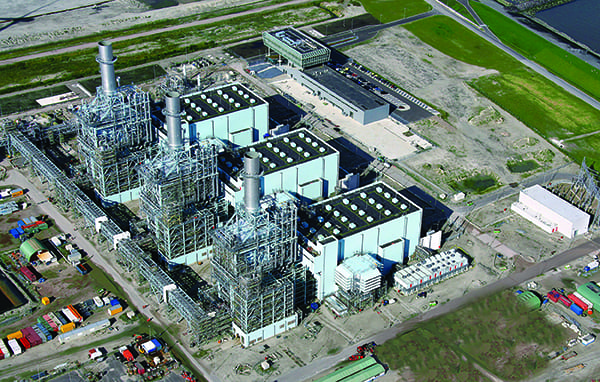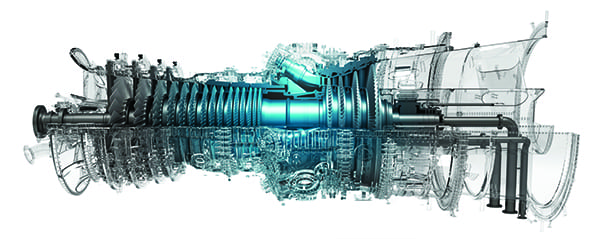One way to help decarbonize the electric grid is through the use of renewable hydrogen, that is, hydrogen produced from renewable power resources. The process involves using excess wind and solar power during periods of oversupply to create hydrogen through electrolysis, then burning the renewable hydrogen in gas turbines when the power is needed on the grid. There are challenges to achieving this goal, but at least one company believes it has a roadmap for overcoming the obstacles.
One of the foundations of modern human prosperity is the reliable generation of vast amounts of electricity. It is what unleashes opportunity and enables economic growth around the world.
Increasingly, the world must balance the need to generate enough electricity to satisfy growing worldwide demand with the global priority of reducing carbon dioxide emissions. The United Nations’ 2018 climate change report was a clarion call for nations to take significant steps toward decarbonizing their energy grids. Government policymakers are already enacting rules and legislation that support a move toward a carbon-free future.
For example, Utah House Bill 109 encourages investment in hydrogen infrastructure that could take advantage of low-cost solar power to produce hydrogen for power production and transportation. Additionally, California Senate Bill 1369 would require the California Public Utilities Commission to consider green electrolytic hydrogen an eligible form of energy storage and consider other potential uses of green electrolytic hydrogen.
Achieving the UN’s energy vision will require developing new technologies and fuels to eliminate carbon dioxide production, as well as modifying existing power generation technologies to reduce the intensity of their environmental impact. Mitsubishi Hitachi Power Systems (MHPS) has brought focus to this effort through its support of the Power Sector Carbon Index, a Carnegie Mellon University project that studies and tracks the intensity of carbon dioxide in the U.S. power sector.
According to this index, U.S. emissions are down 29% since 2005, as power generation has steadily increased. The driving force of this decrease is the switch from coal to gas, which accounts for 54% of the reduction, and the growth of renewables, which accounts for another 40%. The remaining 6% is due to other factors, such as efficiency gains in existing technologies.
The U.S. is on the right path, but as the country continues to decarbonize the grid, new challenges emerge, such as how to use a carbon-free energy source during gaps in generation of wind and solar. MHPS believes that “renewable hydrogen” (hydrogen produced from renewable sources) will be an essential fuel of the future as the world continues down the decarbonization path.
Switching to Renewables and Natural Gas
One solution to decarbonizing the grid is to increase the percentage of power obtained from renewable energy sources, such as wind and solar. In 2017, clean-energy sources provided 12% of the world’s energy needs. The solar sector alone grew to $160 billion in investment. The cost of solar power has decreased 65%, and onshore wind 15%, in the past several years—along with the cost of gas turbines, which is decreasing 12% per year thanks to efficiency improvements.
Natural gas will also play an incredibly significant role in decarbonizing the world’s power grids. It’s easy to see why. The mix of natural gas turbines and renewable energy sources offers 85% lower carbon emissions than the coal-fired plants they replace. Today, MHPS gas turbines, such as the combined cycle M501JAC with efficiency approaching 65% and reliability of 99.5%, play a pivotal role as they work with renewables to reduce carbon emissions.
While the growth of renewables points to a future where, by 2040, 40% of the world’s electricity is expected to come from clean energy sources like wind and solar, intermittent renewable energy sources are subject to unpredictable weather patterns. To ensure reliable power generation, generators must have readily available dispatchable resources to offset short-term volatility in renewable generation.
Fossil fuels achieve this, but at a cost many people are no longer willing to pay. To achieve deep decarbonization, there must be a reliable solution to store energy created by renewables for long periods of time so it has the flexibility to deploy power whenever it is needed.
A Hydrogen-Powered Future for Clean Energy with Zero Carbon
Ultimately, to accommodate more renewables on the grid in certain regions, the system will need bulk energy storage solutions. MHPS sees hydrogen as the bulk energy storage solution for a sustainable, cost-effective, and reliable renewable energy future. As the build-out of wind and solar continues, excess renewable energy will increase and can be used to create renewable hydrogen through electrolysis, which uses electricity to split water into hydrogen and oxygen. The resulting hydrogen, a clean fuel that can be used in gas turbines, can be stored for solid-oxide fuel cells, transportation, and chemical production industries.
Renewable hydrogen represents a multifaceted breakthrough. It can be generated from low-cost or free excess renewable energy. It can be stored for long durations, even on a seasonal level. And it can readily be combusted in gas turbines with the proper system design modifications. This makes it ideal to support renewable power and achieve carbon reduction targets. This shift is a “Change in Power,” and one for which MHPS has been preparing.
For hydrogen to take center stage as a fuel source, the infrastructure to make, move, store, and utilize the large quantities of hydrogen requires significant investment. New infrastructure will include building vast networks of electrolyzers, pipelines to transport hydrogen safely, and developing the hydrogen storage capacity, allowing the shift of power generation to periods of higher power demand. MHPS is deeply committed to investing in and building out this new infrastructure, which will set the stage for an energy future powered by hydrogen.
50 Years of H2 Experience, but New Challenges Ahead
MHPS has been a leader in hydrogen-fueled turbine technology for almost 50 years. Currently, MHPS has 29 turbines that use fuel with up to 90% hydrogen content by volume, and these turbines have operated for more than 3.5 million hours.
 |
|
1. Mitsubishi Hitachi Power Systems (MHPS) is supporting the Carbon-Free Gas Power project at Vattenfall’s Magnum power plant in the Netherlands. The project aims to convert one of the three 440-MW combined cycle gas turbines to operate on 100% hydrogen, which will significantly reduce CO2 emissions. Courtesy: MHPS |
Today’s turbine combustion systems are limited in the amount of hydrogen they can burn. MHPS has a development roadmap to solve these challenges and plans to validate a new modern combustion system firing 100% hydrogen. At Vattenfall’s Magnum power plant in Groningen, the Netherlands (Figure 1), MHPS is working to convert a 440-MW combined cycle unit to run on 100% hydrogen. In 2025, when the conversion is complete, the unit will generate zero CO 2 emissions.
Hydrogen-burning combustor technology can be retrofitted on all MHPS turbines currently operating today, when coupled with hydrogen fuel delivery modifications. This allows operators to embrace hydrogen power with minimal changes to their gas turbine fleet. Minimal modifications to current MHPS turbines functioning today will make them a future-proof investment.
Advanced Clean Energy Storage (ACES)
One of the projects MHPS is most excited about is the joint development between the company and Magnum Development, an industry leader in storing and transporting natural gas, of the world’s largest renewable energy storage site, the Advanced Clean Energy Storage (ACES) project. ACES will utilize four technologies: renewable electrolytic hydrogen production and storage, compressed air energy storage (CAES), battery storage, and solid-oxide fuel cells. The batteries and fuel cells will be available for instantaneous generation for short durations of hours. The stored hydrogen will be utilized as fuel for dispatchable on-site turbines, and CAES will provide multi-day or longer storage and generation. By 2025, the ACES project aims to have enough renewable hydrogen to power 250 MW of electricity supply. When completed, the site will be able to supply 1,000 MW of instantaneous electricity.
To enable this massive level of energy storage, the ACES system will be developed on top of the only large salt dome in the Western U.S. Salt domes are unique geological formations virtually impermeable to gases. Caverns can be formed within them to provide an economic form of bulk storage. Cavern sizes range from 1,000 ft to 1,500 ft in height and 150 ft to 300 ft in diameter.
Magnum has identified and secured more than 11,000 acres of surface area above the dome suitable for cavern development, enough to create up to 100 caverns depending on the cavern size and required spacing. So far, five caverns have been successfully created at the site. One medium-sized cavern can hold 5 million kilograms of hydrogen gas—providing more energy storage than the combined capacity of all the grid-scale batteries currently installed in the world.
 |
|
2. All MHPS gas turbines currently operating today can be retrofitted with hydrogen-burning combustor technology, which future-proofs current owners’ investments. Courtesy: MHPS |
MHPS gas turbines (Figure 2) are the key to turning this massive amount of stored renewable hydrogen into a dispatchable source of power. The ACES project enables a fundamentally different storage and discharge model. Rather than thinking about storage in terms of seconds, minutes, or hours, the ACES system enables months of storage by housing massive amounts of energy.
For example, the cavern could be filled with hydrogen in the spring, using excess renewable electricity, and then the renewable hydrogen could be consumed as needed throughout the year, by using it as fuel for gas turbines. This clean energy will serve the power needs of the Western U.S., seamlessly integrating with the current grid infrastructure.
A Clean Energy Future Filled with Opportunity
Renewable hydrogen-powered technology is the solution to a more energy-efficient, carbon dioxide-free future–and incredible strides have been made in recent years. There are still challenges to overcome that vary from the cost of production to the need for efficient storage, but with challenges comes opportunities.
MHPS is excited to address these challenges head on and tap the vast potential available to usher in a clean, more-efficient future. From future-proofing current product offerings with new technologies to investments in new products for customers, MHPS sees a hydrogen society that is ready for the future. Taken together, these steps lead to a carbon dioxide-free future completely powered by renewables, made dispatchable by hydrogen. That’s the “Change in Power” that the planet needs.■
—Don Daniels is Chief Strategy Officer with Mitsubishi Hitachi Power Systems Americas.
https://www.powermag.com/decarbonizing-the-power-sector-with-renewable-gas/